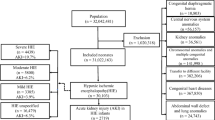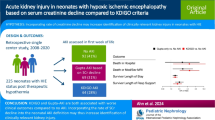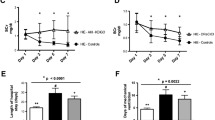Abstract
Background
The objective of this study was to evaluate the prognostic role of postnatal acute kidney injury (AKI) on neurodevelopmental outcome in infants with hypoxic-ischemic encephalopathy (HIE) receiving therapeutic hypothermia (TH).
Methods
This is a prospective observational study including all neonates with HIE receiving TH between 2009 and 2016 at a single center. AKI was classified according to the Kidney Disease: Improving Global Outcomes definition modified for neonatal age. Child development was assessed using the Griffiths Mental Development Scales (GMDS). Study outcome was defined as unfavorable outcome (including death or disability according to GMDS) or favorable otherwise, at 12 and 24 months.
Results
One-hundred and one neonates (median gestational age 39 weeks) were included. AKI was diagnosed in 10 neonates (10%). Seven patients died within the first year, 35 patients had disability at 12 months, and 45 patients at 24 months. AKI was associated with increased likelihood of unfavorable outcome at 24 months (100% vs. 59% in neonates without AKI; p = 0.01). AKI showed good positive predictive value (1.00, 95% CI 0.71–1.00) and specificity (1.00, 95% CI 0.88–1.00), but poor negative predictive value (0.41, 95% CI 0.30–0.52) and sensitivity (0.19, 95% CI 0.11–0.32) at 24 months.
Conclusions
AKI might be a reliable indicator of death or long-term disability in infants with HIE receiving TH, but the absence of AKI does not guarantee a favorable long-term outcome.



Similar content being viewed by others
References
Natarajan G, Laptook A, Shankaran S (2018) Therapeutic hypothermia: how can we optimize this therapy to further improve outcomes? Clin Perinatol 45:241–255
Kurinczuk JJ, White-Koning M, Badawi N (2010) Epidemiology of neonatal encephalopathy and hypoxic-ischaemic encephalopathy. Early Hum Dev 86:329–338
Jacobs SE, Berg M, Hunt R, Tarnow-Mordi WO, Inder TE, Davis PG (2013) Cooling for newborns with hypoxic ischaemic encephalopathy. Cochrane Database Syst Rev 1:CD003311
Azzopardi D, Strohm B, Marlow N, Brocklehurst P, Deierl A, Eddama O, Goodwin J, Halliday HL, Juszczak E, Kapellou O, Levene M, Linsell L, Omar O, Thoresen M, Tusor N, Whitelaw A, Edwards AD, TOBY Study Group (2014) Effects of hypothermia for perinatal asphyxia on childhood outcomes. N Engl J Med 371:140–149
Durkan AM, Alexander RT (2011) Acute kidney injury post neonatal asphyxia. J Pediatr 158:e29–e33
Rollins N, Booth T, Morriss MC, Sanchez P, Heyne R, Chalak L (2014) Predictive value of neonatal MRI showing no or minor degrees of brain injury after hypothermia. Pediatr Neurol 50:447–451
Sarnat HB, Sarnat MS (1976) Neonatal encephalopathy following fetal distress. A clinical and electroencephalographic study. Arch Neurol 33:696–705
Thoresen M, Hellstrom-Westas L, Liu X, de Vries LS (2010) Effect of hypothermia on amplitude-integrated electroencephalogram in infants with asphyxia. Pediatrics 126:e131–e139
Shellhaas RA, Kushwaha JS, Plegue MA, Selewski DT, Barks JD (2015) An evaluation of cerebral and systemic predictors of 18-month outcomes for neonates with hypoxic ischemic encephalopathy. J Child Neurol 30:1526–1531
Bonifacio SL, deVries LS, Groenendaal F (2015) Impact of hypothermia on predictors of poor outcome: how do we decide to redirect care? Semin Fetal Neonatal Med 20:122–127
Trevisanuto D, Doglioni N, Altinier S, Zaninotto M, Plebani M, Zanardo V (2009) Cardiac troponin I at birth is of fetal-neonatal origin. Arch Dis Child Fetal Neonatal Ed 94:F464–F466
Tanigasalam V, Bhat V, Adhisivam B, Sridhar MG (2016) Does therapeutic hypothermia reduce acute kidney injury among term neonates with perinatal asphyxia? A randomized controlled trial. J Matern Fetal Neonatal Med 29:2545–2548
Sarkar S, Askenazi DJ, Jordan BK, Bhagat I, Bapuraj JR, Dechert RE, Selewski DT (2014) Relationship between acute kidney injury and brain MRI findings in asphyxiated newborns after therapeutic hypothermia. Pediatr Res 75:431–435
Cainelli E, Trevisanuto D, Cavallin F, Manara R, Suppiej A (2018) Evoked potentials predict psychomotor development in neonates with normal MRI after hypothermia for hypoxic-ischemic encephalopathy. Clin Neurophysiol 129:1300–1306
Khwaja A (2012) KDIGO clinical practice guidelines for acute kidney injury. Nephron Clin Pract 120:179–184
Selewski DT, Charlton JR, Jetton JG, Guillet R, Mhanna MJ, Askenazi DJ, Kent AL (2015) Neonatal acute kidney injury. Pediatrics 136:e463–e473
Griffiths R (1996) In: Huntley M, editor. The Griffiths mental development scales: from birth to 2 years. Manual rev. The Test Agency, Oxford
R Core Team (2018) R: A language and environment for statistical computing. R Foundation for Statistical Computing, Vienna, Austria. URL https://www.R-project.org/
Agras PI, Tarcan A, Baskin E, Cengiz N, Gurakan B, Saatci U (2004) Acute renal failure in the neonatal period. Ren Fail 26:305–309
Gupta BD, Sharma P, Bagla J, Parakh M, Soni JP (2005) Renal failure in asphyxiated neonates. Indian Pediatr 42:928–934
Askenazi DJ, Ambalavanan N, Goldstein SL (2009) Acute kidney injury in critically ill newborns: what do we know? What do we need to learn? Pediatr Nephrol 24:265–274
Selewski DT, Jordan BK, Askenazi DJ, Dechert RE, Sarkar S (2013) Acute kidney injury in asphyxiated newborns treated with therapeutic hypothermia. J Pediatr 162:725–729.e1
Perlman JM, Tack ED (1988) Renal injury in the asphyxiated newborn infant: relationship to neurologic outcome. J Pediatr 113:875–879
Acknowledgments
We are grateful to the parents of babies enrolled in the study. We thank the medical staff and nurses for their support.
Author information
Authors and Affiliations
Corresponding author
Ethics declarations
This study was performed as part of a project on perinatal asphyxia approved by the Ethics Committee of the Azienda Ospedaliera di Padova in Padua, Italy (number 67575 RF-2009-1511075) and written informed consent was obtained from the parents.
Conflict of interest
The authors declare that they have no conflicts of interest.
Additional information
Publisher’s note
Springer Nature remains neutral with regard to jurisdictional claims in published maps and institutional affiliations.
Rights and permissions
About this article
Cite this article
Cavallin, F., Rubin, G., Vidal, E. et al. Prognostic role of acute kidney injury on long-term outcome in infants with hypoxic-ischemic encephalopathy. Pediatr Nephrol 35, 477–483 (2020). https://doi.org/10.1007/s00467-019-04406-4
Received:
Revised:
Accepted:
Published:
Issue Date:
DOI: https://doi.org/10.1007/s00467-019-04406-4




